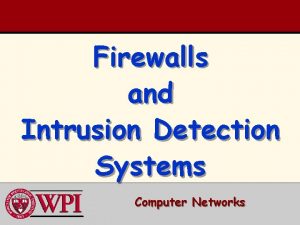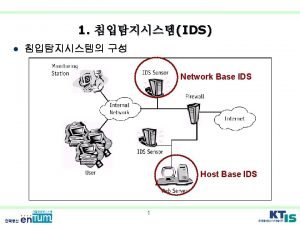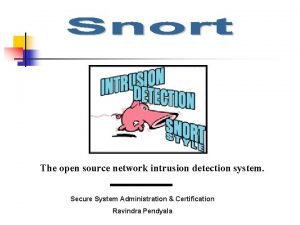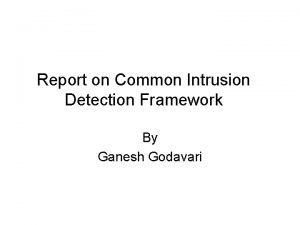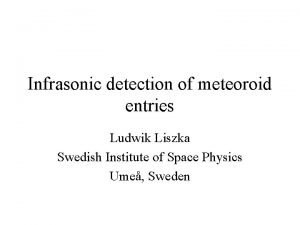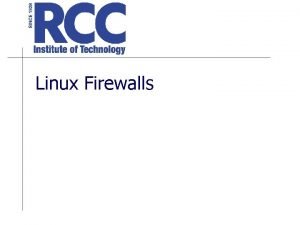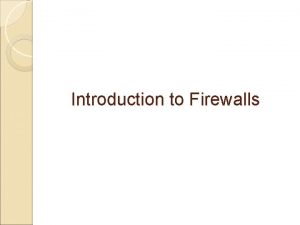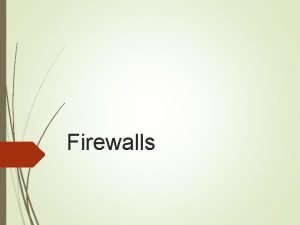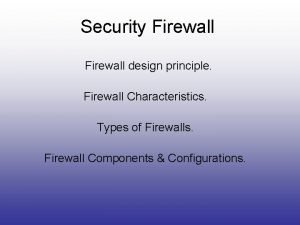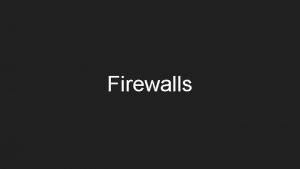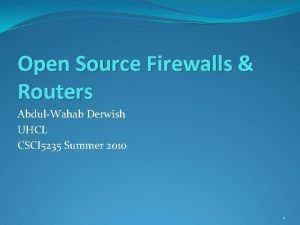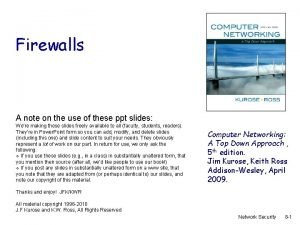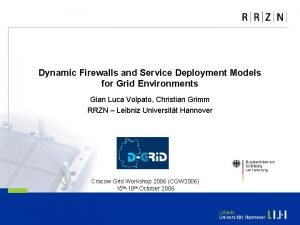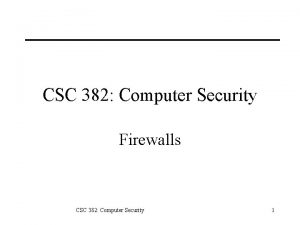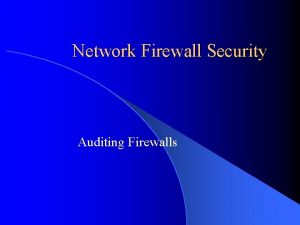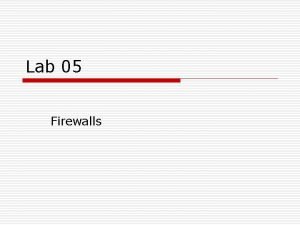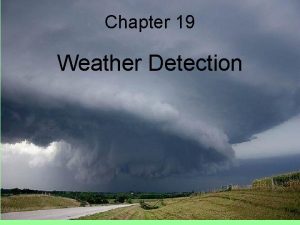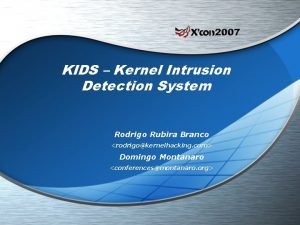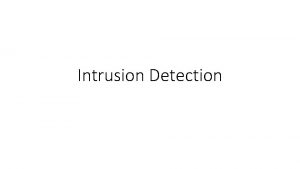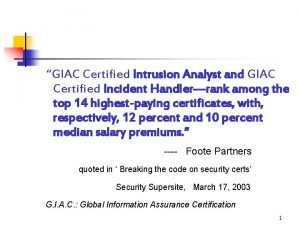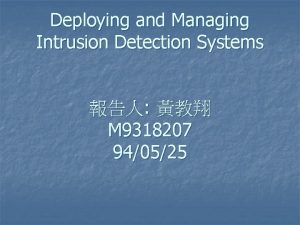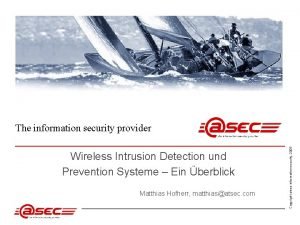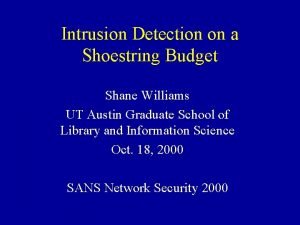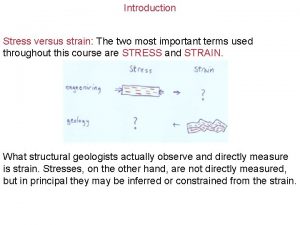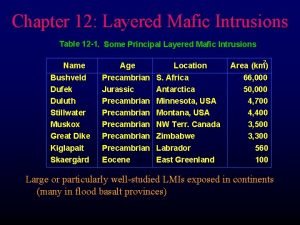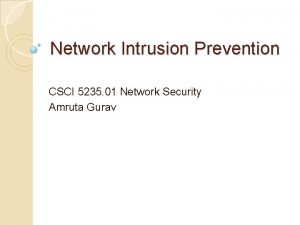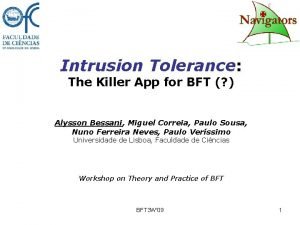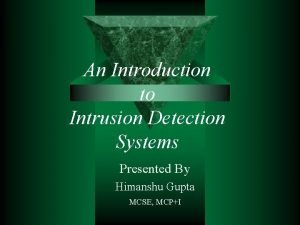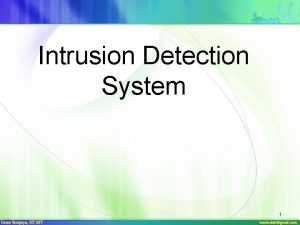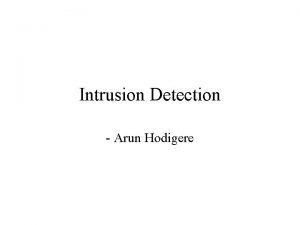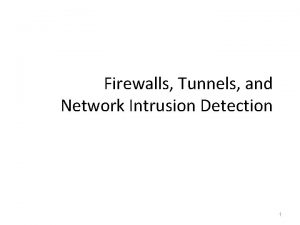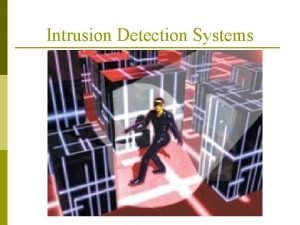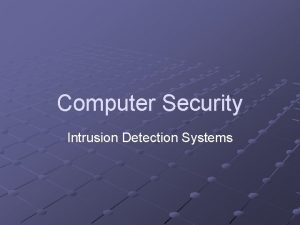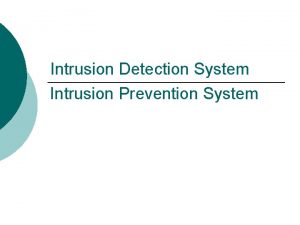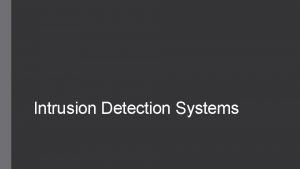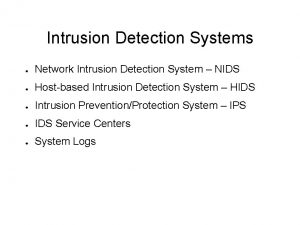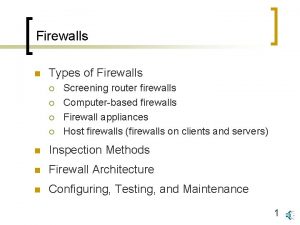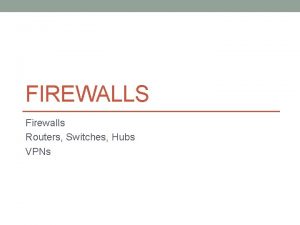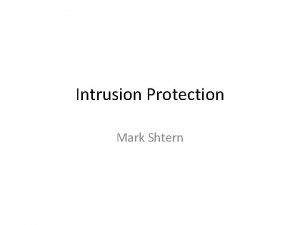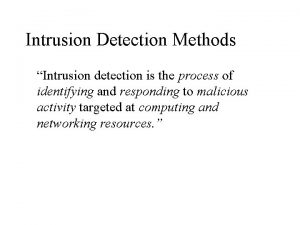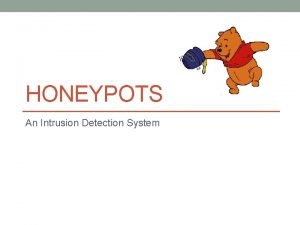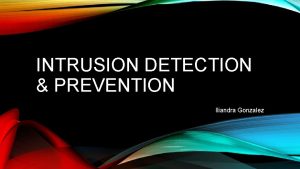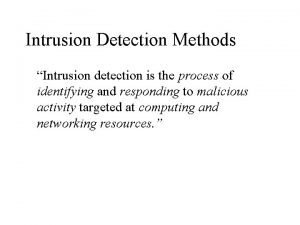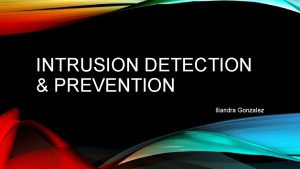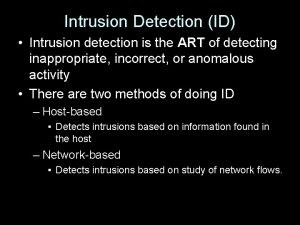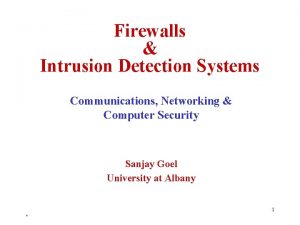CSE 4905 Firewalls Intrusion Detection Systems 8 1


































![TCP Attacks on NIDS [Vitaly Shmatikov] Insertion attack U S E X r R TCP Attacks on NIDS [Vitaly Shmatikov] Insertion attack U S E X r R](https://slidetodoc.com/presentation_image/6a04e540a0f3b93dc6ac038bbf530bd6/image-35.jpg)









- Slides: 44

CSE 4905 Firewalls & Intrusion Detection Systems 8 -1

Protecting an organization’s network v v v Prevent, detect and stop denial of service attacks Detect attempted and successful break-ins Detect and stop worms, botnets … Protect servers that need to be accessed from outside … 8 -2

Firewalls firewall isolates organization’s internal net from larger Internet, allowing some packets to pass, blocking others administered network public Internet Firewall: combination of hardware & software system 8 -3

Firewall design goals v All traffic from inside to outside, and vice versa, must pass through the firewall v Only authorized traffic as defined by the local security policy will be allowed to pass v The firewall itself is immune to penetration (e. g. , hardened system with secure operating system) 8 -4

Firewall access policy v v lists the types of traffic authorized to pass through the firewall Includes address ranges, protocols, applications and content types Should be developed from the organization’s information security risk assessment and policy Based on a broad specification of which traffic types the organization needs to support § Then refined to detail the filter elements which can then be implemented within an appropriate firewall topology 8 -5

Types of firewalls v Stateless packet filtering firewall v Stateful inspection firewall v Application-level firewall 8 -6

Stateless packet filtering Should arriving packet be allowed in? Departing packet let out? v v internal network connected to Internet via router firewall router filters packet-by-packet, decision to forward/drop packet based on: § source IP address, destination IP address § TCP/UDP source and destination port numbers § ICMP message type § TCP SYN and ACK bits 8 -7

Stateless packet filtering: example v v example 1: block incoming and outgoing datagrams with IP protocol field = 17 and with either source or dest port = 23 § result: all incoming, outgoing UDP flows and telnet connections are blocked example 2: block inbound TCP segments with ACK=0. § result: prevents external clients from making TCP connections with internal clients, but allows internal clients to connect to outside. 8 -8

Stateless packet filtering: more examples Policy Firewall Setting No outside Web access. Drop all outgoing packets to any IP address, port 80 No incoming TCP connections, except those for institution’s public Web server only. Drop all incoming TCP SYN packets to any IP except 130. 207. 244. 203, port 80 Prevent Web-radios from eating up the available bandwidth. Drop all incoming UDP packets except DNS and router broadcasts. Prevent your network from being used for a smurf Do. S attack. Drop all ICMP packets going to a “broadcast” address (e. g. 130. 207. 255). Prevent your network from being tracerouted Drop all outgoing ICMP TTL expired traffic 8 -9

Access Control Lists v ACL: table of rules, applied top to bottom to incoming packets: (action, condition) pairs action source address dest address allow 222. 22/16 outside of 222. 22/16 allow outside of 222. 22/16 deny all 222. 22/16 outside of 222. 22/16 protocol source port dest port flag bit TCP > 1023 80 TCP 80 > 1023 ACK UDP > 1023 53 --- UDP 53 > 1023 ---- all all any 8 -10

Stateless packet filtering: netsec v v v Only ssh is allowed to netsec. engr. uconn. edu for external hosts Everything is allowed for internal hosts (i. e. , within UConn) Can the above access policy be realized using firewall? How? v IP address of netsec. engr. uconn. edu: 137. 99. 3. 201 8 -11

Weaknesses of packet filtering v Do not prevent application-specific attacks § For example, if there is a buffer overflow in the Web server, firewall will not block an attack string v v IP spoofing: router can’t know if data “really” comes from claimed source Vulnerable to misconfiguration 8 -12

Stateless filtering is not enough v In TCP connections, ports with numbers less than 1024 are permanently assigned to servers § 20, 21 - FTP, 23 - telnet, 25 - SMTP, 80 - HTTP… v Clients use ports numbered from 1024 to 65535 § They must be available for clients to receive responses v What should a firewall do if it sees an outgoing request to some client’s port 5151? § This could be a server’s response in a previously established connection, OR it could be malicious traffic § Can’t tell without keeping state for each connection 8 -13

Stateless filtering is not enough II v admits packets that “make no sense, ” e. g. , dest port = 80, ACK bit set, even though no TCP connection established: action allow source address dest address outside of 222. 22/16 protocol source port dest port flag bit TCP 80 > 1023 ACK 8 -14

Stateful packet filtering v track status of every TCP connection § track connection setup (SYN), teardown (FIN): determine whether incoming, outgoing packets “makes sense” § timeout inactive connections at firewall: no longer admit packets 8 -15

Stateful packet filtering v ACL augmented to indicate need to check connection state table before admitting packet action source address dest address proto source port dest port allow 222. 22/16 outside of 222. 22/16 TCP > 1023 80 allow outside of 222. 22/16 TCP 80 > 1023 ACK allow 222. 22/16 UDP > 1023 53 --- allow outside of 222. 22/16 UDP 53 > 1023 ---- deny all all all 222. 22/16 outside of 222. 22/16 flag bit check conxion any x x 8 -16

Application gateways v v host-to-gateway filter packets on telnet session application data as well as on IP/TCP/UDP fields. example: allow select internal users to telnet outside application gateway router and filter gateway-to-remote host telnet session 1. require all telnet users to telnet through gateway. 2. for authorized users, gateway sets up telnet connection to dest host. Gateway relays data between 2 connections 3. router filter blocks all telnet connections not originating from gateway. 8 -17

Limitations of firewalls, gateways v v v IP spoofing if multiple apps. need special treatment, each has own app. gateway client software must know how to contact gateway. § e. g. , must set IP address of proxy in web browser v Don’t solve many real problems § Buggy software (think buffer overflow exploits) § Bad protocol design (think WEP in 802. 11 b) v v Generally don’t prevent denial of service Don’t prevent insider attacks 8 -18

Intrusion detection systems (IDS) v packet filtering: § operates on TCP/IP headers only § no correlation check among sessions v IDS: intrusion detection system § deep packet inspection: look at packet contents (e. g. , check character strings in packet against database of known virus, attack strings) § examine correlation among multiple packets • port scanning • network mapping • Do. S attack 8 -19

Definitions from RFC 2828 (Internet Security Glossary) v Security Intrusion: A security event, or a combination of multiple security events, that constitutes a security incident in which an intruder gains, or attempts to gain, access to a system (or system resource) without having authorization to do so. v Intrusion Detection: A security service that monitors and analyzes system events for the purpose of finding, and providing real-time or near real-time warning of, attempts to access system 8 -20

Types of IDS v Host-based intrusion detection § Monitors the characteristics of a single host for suspicious activity v Network-based intrusion detection § Monitors network traffic and analyzes network, transport, and application protocols to identify suspicious activity v Three logic components in IDS § Sensors: collect data § Analyzers: determine if intrusion has occurred § User interface: view output or control system behavior 8 -21

Assumption of intrusion detection v v v Behavior of intruders differ from that of legitimate users In practice, their behavior can overlap What to hope for: IDS with high detection rate and low false alarm rate 8 -23

IDS requirements v v v v v Run continually w/ minimal human intervention Fault tolerant Resist subversion Impose a minimal overhead on the system that it’s running Configured according to system security policies Adapt to changes in systems and users Scale to monitor large numbers of systems Provide graceful degradation of service Allow dynamic reconfiguration 8 -24

Analysis approaches v Anomaly detection § Collecting data relating to the behavior of legitimate users over a period of time § Current observed behavior is analyzed to determine whether this behavior is that of a legitimate user or not § Can detect unknown attacks § Statistical, knowledge based or machine learning techniques v Signature or heuristic detection § Use know malicious data patterns (signatures) or attack rules (heuristics) § Can only detect known attacks 8 -25

Host-based intrusion detection system (HIDS) v v v Security software on vulnerable or sensitive systems (e. g. , database servers or administrative systems) Can detect both internal and external intrusions Sensor data § § v System call traces Audit (log file) records: user activity File integrity checksums (cryptographic checksums) Registry access Techniques § Anomaly detection § Signature or heuristic rules 8 -26

Network-based IDS: types of network sensors v Inline sensor: inserted into network segment § Stand-alone or with another network device (e. g. , firewall or LAN switch) § Traffic pass through sensor § Can detect and block an attack; may cause extra latency v Passive sensors § Tap to network transmission medium Passive sensor 8 -28

Network-based IDS: sensor placement 8 -29

Network-based IDS: sensor placement II v In external firewall § See all incoming (filtered by firewall) and outgoing traffic § Highlight problems with firewall policy or performance § See attacks that might target service servers (e. g. , web or mail servers) § Recognize outgoing traffic from compromised servers v Outside external firewall § See all incoming and outgoing traffic (filtered by firewall) § Document # and type of attacks targeting the network § High processing burden v Inside network (tuned to specific attack types) § Protect major backbone networks (internal servers and database resources) in organization § Protect critical subsystems 8 -30

Network-based IDS: techniques v Many commercial products v many techniques § Signature detection • On different protocols (application, transport, IP, ICMP, etc. ) § Anomaly detection • Do. S attacks • Network scanning • worms § Stateful protocol analysis 8 -31

Example system: Snort v v v Open-source, highly configurable and portable host-based or network-based IDS Light-weight IDS § Small amount of memory and CPU, easily configured by experienced administrators v Functions § Real-time packet capture § Protocol analysis § Content search and matching v Can be configured to be inline sensor (intrusion prevention) or passive sensor (intrusion detection)8 -32

Snort: Rule-based detection engine 8 -33

Snort: example Alert tcp $EXTERNAL_NET any -> $HOME_NET any (msg: “SCAN SYN FIN” flags: SF 12; reference: arachnids, 198; classtype: attempted-recon; ) v v Rule options in the format of v option-keyword: option-arguments Example rule options v msg: defines the message to be sent when a packet generates an event v flags: test the TCP flags for specified settings v reference: defines a link to an external attack identification system, which provides additional info. 8 -34

Why intrusion detection is hard? v Signature matching § Detecting attack strings is hard, even if signature is known §… v Anomaly § § detection What is anomaly? Training is difficult Can have high false positives … 8 -35

Detecting attack strings is hard [Vitaly Shmatikov Suppose want to detect “USER root” in packet stream v Scanning for it in every packet is not enough v § Attacker can split attack string into several packets; this will defeat stateless NIDS v Recording previous packet’s text is not enough § Attacker can send packets out of order v Full reassembly of TCP state is not enough § Attacker can use TCP tricks so that certain packets are seen by NIDS but dropped by the receiving application • Manipulate checksums, TTL (time-to-live), fragmentation 8 -36
![TCP Attacks on NIDS Vitaly Shmatikov Insertion attack U S E X r R TCP Attacks on NIDS [Vitaly Shmatikov] Insertion attack U S E X r R](https://slidetodoc.com/presentation_image/6a04e540a0f3b93dc6ac038bbf530bd6/image-35.jpg)
TCP Attacks on NIDS [Vitaly Shmatikov] Insertion attack U S E X r R o o t U S E R r o o t X Insert packet with bogus checksum TTL attack 10 hops U S E R r Short TTL to ensure this packet doesn’t reach destination o Dropped 8 hops U TTL=20 X o NIDS t TTL=12 TTL=20 S E R r o o t X NIDS Dropped (TTL expired) 8 -37

Anomaly detection is hard v Training is difficult § Lack of training data with real attacks § Network traffic is very diverse, the definition of “normal” is constantly evolving • What is the difference between a flash crowd and a denial of service attack? v v Protocols are finite-state machines, but current state of a connection is hard to see from network False positive rate can be high § False identifications are very costly because sys admin will spend many hours examining evidence 8 -38

Intrusion detection errors v False negatives: attack is not detected § Big problem in signature-based misuse detection v False positives: harmless behavior is classified as an attack § Big problem in statistical anomaly detection v v All intrusion detection systems (IDS) suffer from errors of both types Which is a bigger problem? § Attacks are fairly rare events, thus IDS often suffer from the base-rate fallacy 8 -39

Conditional Probability v v v Suppose two events A and B occur with probability Pr(A) and Pr(B), respectively Let Pr(AB) be probability that both A and B occur What is the conditional probability that A occurs assuming B has occurred? Pr(A | B) = Pr(AB) Pr(B) 8 -40

Base-Rate Fallacy v 1% of traffic is SYN floods; IDS accuracy is 90% § IDS classifies a SYN flood as attack with prob. 90%, classifies a valid connection as attack with prob. 10% v What is the probability that a connection flagged by IDS as a SYN flood is actually valid? Pr(valid | alarm) = = Pr(alarm | valid) Pr(valid) Pr(alarm | valid) Pr(valid) + Pr(alarm | SYN flood) Pr(SYN flood) 0. 10 0. 99 = 0. 10 0. 99 + 0. 90 0. 01 = 92% chance raised alarm is false!!! 8 -42

Unified threat management (UTM) system v Definition (by IDC) § Products that include multiple security features integrated into one box § Be able to perform network firewalling, network intrusion detection and prevention and gateway anti-virus § All of the capabilities need not be used concurrently, but the functions must exist inherently v Performance is big issue § How to keep up with throughput and reduce latency? § Typical throughput loss of current commercial products (50%, 2006) 8 -43

UTM architecture 8 -44

Network Function Virtualization (NFV) v initiative to virtualize the network services that are now being carried out by proprietary, dedicated hardware § software implementations of network functions for • firewall • Intrusion detection system • … § Many implementations of NFV rely on Software Defined Networking (SDN) 8 -45

Summary v Firewall § Type of firewalls § pros and cons of each type v What is security intrusion? v Intrusion detection § Basic assumption and techniques § Host-based and network-based IDS v Challenges of intrusion detection v Unified threat management system 8 -46

References v Chapter 8. 9 “Operational Security: Firewall and Intrusion Detection Systems” in Kurose & Ross’s book v “Insertion, Evasion and Denial of Service: Eluding Network Intrusion Detection” by Ptacek and Newman 8 -47
 Firewalls and intrusion detection systems
Firewalls and intrusion detection systems Intrusion detection systems (ids)
Intrusion detection systems (ids) Fiber perimeter intrusion detection systems
Fiber perimeter intrusion detection systems Nids open source
Nids open source Common intrusion detection framework
Common intrusion detection framework Bro intrusion detection
Bro intrusion detection Infrasonic intrusion detection
Infrasonic intrusion detection History of the firewall
History of the firewall Introduction to firewalls
Introduction to firewalls What is stateful and stateless firewall
What is stateful and stateless firewall Characteristics of a firewall
Characteristics of a firewall Linux firewalls
Linux firewalls Firewalls are used for what security principle
Firewalls are used for what security principle Carp vs vrrp
Carp vs vrrp Types of firewalls ppt
Types of firewalls ppt Dynamic firewalls
Dynamic firewalls Perimeter firewalls are the simplest type of firewall
Perimeter firewalls are the simplest type of firewall Auditing firewalls
Auditing firewalls Firewalls computer science
Firewalls computer science Ssh works
Ssh works Lightening radar
Lightening radar Kernel: intrusion
Kernel: intrusion Language meaning
Language meaning Intrusión dental definicion
Intrusión dental definicion Magmatic intrusion
Magmatic intrusion Giac intrusion analyst
Giac intrusion analyst Immersive fantasy
Immersive fantasy Intrusion.win.iis.unicode.a.exploit
Intrusion.win.iis.unicode.a.exploit Datenkorrelation
Datenkorrelation Laws of superposition
Laws of superposition Intrusion budget
Intrusion budget Authorial intrusion in the crucible
Authorial intrusion in the crucible Intrusion movie
Intrusion movie Intrusion movie
Intrusion movie Risitic layering
Risitic layering Relative dating
Relative dating Silver ticket attack
Silver ticket attack Configure ios intrusion prevention system (ips) using cli
Configure ios intrusion prevention system (ips) using cli Intrusion tolerance
Intrusion tolerance Ips intrusion
Ips intrusion Analysis console for intrusion databases
Analysis console for intrusion databases Decision support systems and intelligent systems
Decision support systems and intelligent systems Principles of complex systems for systems engineering
Principles of complex systems for systems engineering Embedded systems vs cyber physical systems
Embedded systems vs cyber physical systems Elegant systems
Elegant systems
